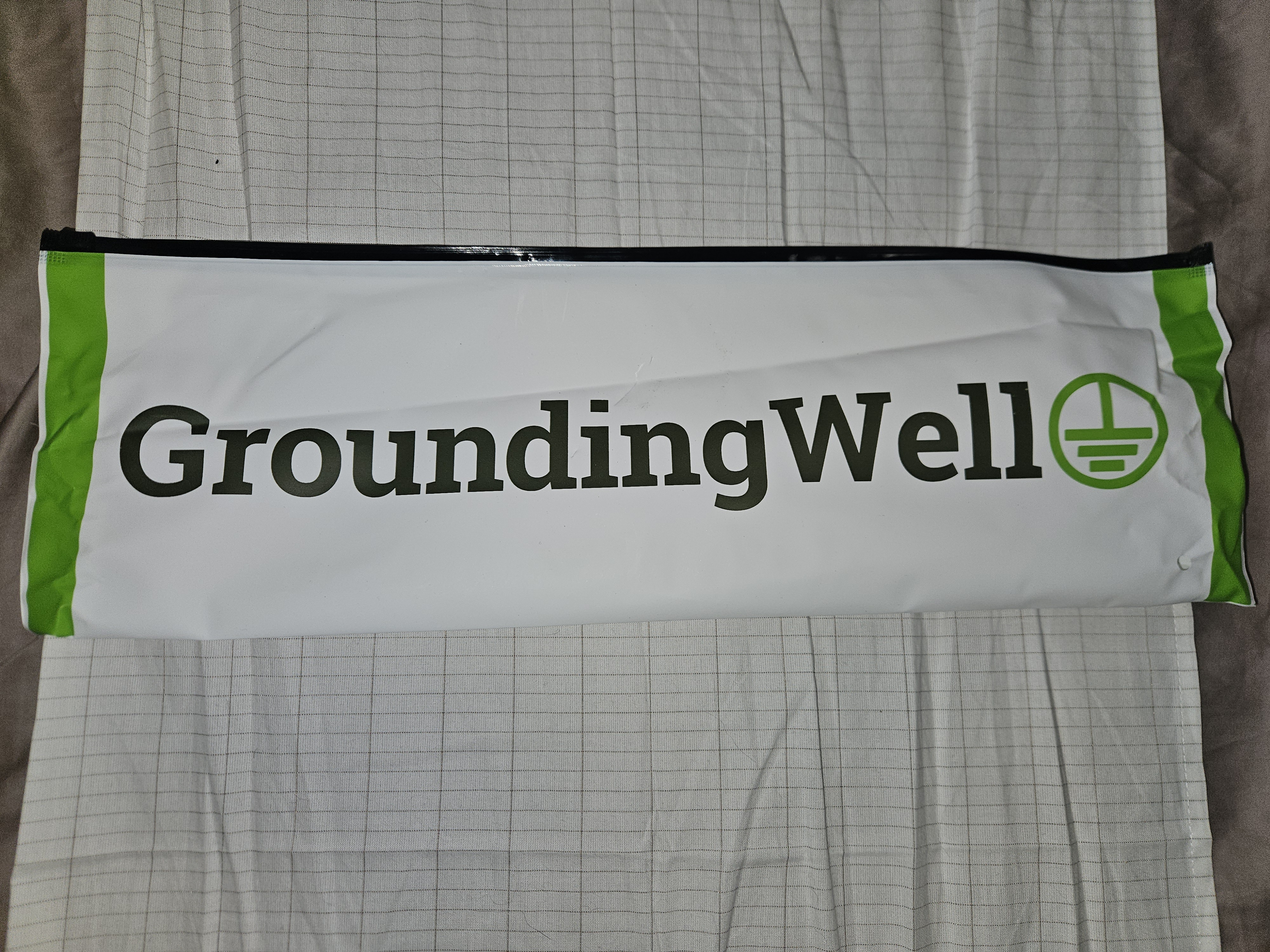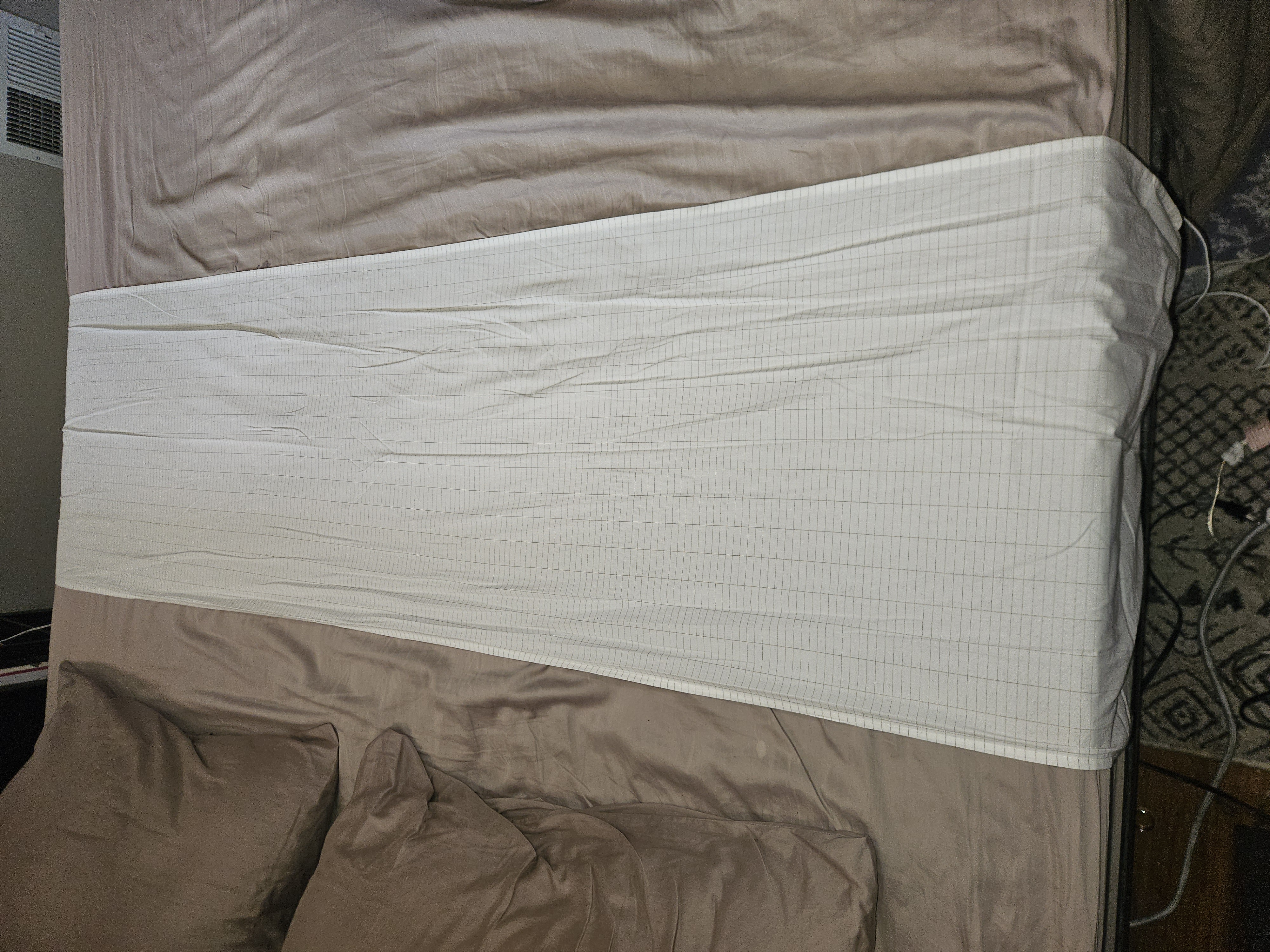Note: I’ll be switching between the terms “grounding” and “earthing” throughout this article. They can be used interchangeably. I’ll use either one of these terms when referring to the practice of a person making contact with the Earth. When referring to electrical systems, I’ll use the term “electrical grounding.”
Because I’ve recently become active in professional boxing again—at the age of 40 and after a nearly 9-year lay-off—I’m always looking for ways to get a physical and mental advantage without relying on any substances or practices that go against the World Anti-Doping Agency (WADA) protocol.
 Unlike most boxers, I have a degree in Physics and that study has trained me to understand and dissect research. That educational background, combined with my commitment to competing at a high level of professional boxing as long as I can—while also aging gracefully without any health issues—has led me to some effective supplements and practices that most people or fighters are not aware of.
Unlike most boxers, I have a degree in Physics and that study has trained me to understand and dissect research. That educational background, combined with my commitment to competing at a high level of professional boxing as long as I can—while also aging gracefully without any health issues—has led me to some effective supplements and practices that most people or fighters are not aware of.
One of the practices that I’ve recently discovered is called “Grounding” or “Earthing.”
In this article, I will explain exactly what Earthing is, how grounding works, and why I believe that it’s an underrated tool, not just for athletes of all levels, but for people who want to be the healthiest version of themselves.
Maybe you found this article because you’re thinking about buying a grounding sheet or grounding mat. I got mine from Grounding Well and I don’t have a single complaint about my mat or my sheet.
If this article helps you make a decision, I recommend a few grounding products at the end. If you purchase them from the link provided, I receive a small commission, so it’s an easy way to support my site and say “thank you” for helping you make a decision.
With all of that said, before we dig into how earthing works or what benefits you can hope to obtain, we have to go through a brief physics lesson on electricity.
Even if you know how electrical circuits work, I strongly recommend you don’t skip this section, as this knowledge is vital to understanding how the earthiing version of grounding works and the mechanisms of action for all of the benefits reported anecdotally and in research studies.
This will be short and easy to understand. I will also keep the specific jargon to a minimum unless absolutely necessary. However, feel free to skip ahead to the explanation of Earthing and the benefits gained from Earthing by clicking below.
Skip to the health benefits of grounding
The science of electrical grounding

Most power outlets have either two or three holes, as most electrical devices have two or three prongs to plug into those holes. For now, I’m going to ignore the third prong and focus exclusively on the function of the first two prongs.
Electricity is merely the flowing of electrons(this is a very important idea, so remember it). Those electrons need a closed path (circuit) to flow through. When you plug an appliance or device into a circuit, you’re providing a path for the current to flow and the electricity to make the appliance or device work. One prong is hot (live), delivering current to the device. The other is neutral, which completes the circuit by returning current back to the power source.
To make your daily appliances function, you only need two prongs on every device: one to carry the electricity in and another to take it out. That completes a circuit. So, why do many outlets have a third hole, and why do many devices have a third prong beneath the two necessary plugs?
Well, because sometimes, bad things happen.
Before we go further, let’s define “current.” “Current” is the flow of electrons per a certain unit of time, measured in units called “amps.”
Most of us know that plugging too many devices into the same circuit can cause the circuit breaker to trip/fuse to blow, shutting down everything plugged into that circuit. Why does this happen?
Every device you plug in draws additional current. If you draw too much current, you’ll trip the breaker or blow a fuse, shutting down everything on that circuit. This is a safety precaution to prevent excess current from damaging anything, shocking anyone, or starting a fire.
When this happens, most people just call it a “short.”
Note: I won’t delve into the technical differences in this article, but please note that this isn’t technically a “short,” although I’ll continue to use this word because the distinction doesn’t impact our understanding of grounding, and it helps to drive the idea home. I just wanted to bring this point to the attention of anyone with an electrical background who is reading this.
Just take “short” to mean that the circuit is broken because the current going through the wire exceeds what it can safely handle. Again, not the technically precise definition, but it is useful enough to convey the idea for the rest of the article.
So what about that third prong? What is that for?
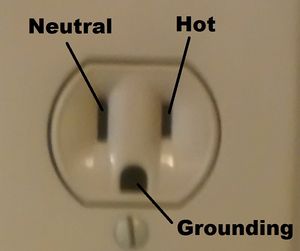
The “grounding prong” connects any exposed metal parts of the appliance to the home’s grounding system. If a live wire touches the metal, current will flow safely through that ground path instead of through you or the device. This sudden surge of current also trips the breaker or blows the fuse almost instantly, cutting power and preventing shock.
Appliances with exposed metal parts (such as a refrigerator’s casing or a microwave’s housing) require a third prong so that if a live wire inside ever touches that metal, the current has a safe, low-resistance path to ground (the Earth). It’s not about how much current the appliance uses, but about whether exposed conductive surfaces could become dangerous.
But why use the Earth as the place to send excess current?
Here’s where a little high-school chemistry helps. Atoms are made of protons (positive charge), neutrons (no charge), and electrons (negative charge). In wires, electricity is simply the flow of those electrons. Because opposite charges attract and like charges repel, a buildup of extra electrons naturally wants to escape to someplace more neutral.
The Earth is the ultimate neutral reservoir. It’s so massive that adding or removing electrons doesn’t change its overall balance — it always stays essentially at zero. By connecting our electrical systems to the Earth, we provide a safe path for the current that’s escaped its circuit path to flow.
In electrical systems, the ground wire path also goes through the breaker/fuseThis keeps metal cases from becoming live, trips breakers quickly during faults, and drains away dangerous surges from lightning or static. In short, the Earth is our electrical safety net: vast, stable, and always ready to absorb excess charge.
Key takeaways before we explain how Earthing works
- Electricity basics: Electricity is the movement of electrons. It always needs a closed circuit (a complete path) to flow. On your power cord, the hot prong delivers current and the neutral prong carries it back to the source.
- Two prongs are all you need for electronic devices to function: Any device only needs hot and neutral to operate. That’s all it takes to complete a circuit and power your appliances.
- The purpose of the third prong (ground): When faults occur—like a live wire coming loose and touching exposed a metal casing—the ground prong provides a safe, low-resistance escape route for current into the ground.
- Electrical rounding is about safety: Appliances and devices with exposed metal parts (e.g., refrigerators, microwaves, washers) need grounding because their casings could become energized.
- Why the Earth is used as ground: The Earth is a vast, stable reservoir of electric charge. It’s so large that adding or removing electrons doesn’t make it electrified. Connecting systems to the Earth maintains a safe path for fault current and surges to dissipate. This stabilizes the entire electrical system, prevents shock hazards, and safely dissipates electrical surges (like lightning strikes) or fault currents (shorts or wires coming losing touching the electrically conductive insides).
Now you understand the basic idea of a how the Earth functions as a ground, electricity, and atoms. All of this is important for understanding how the practice of Earthing works.
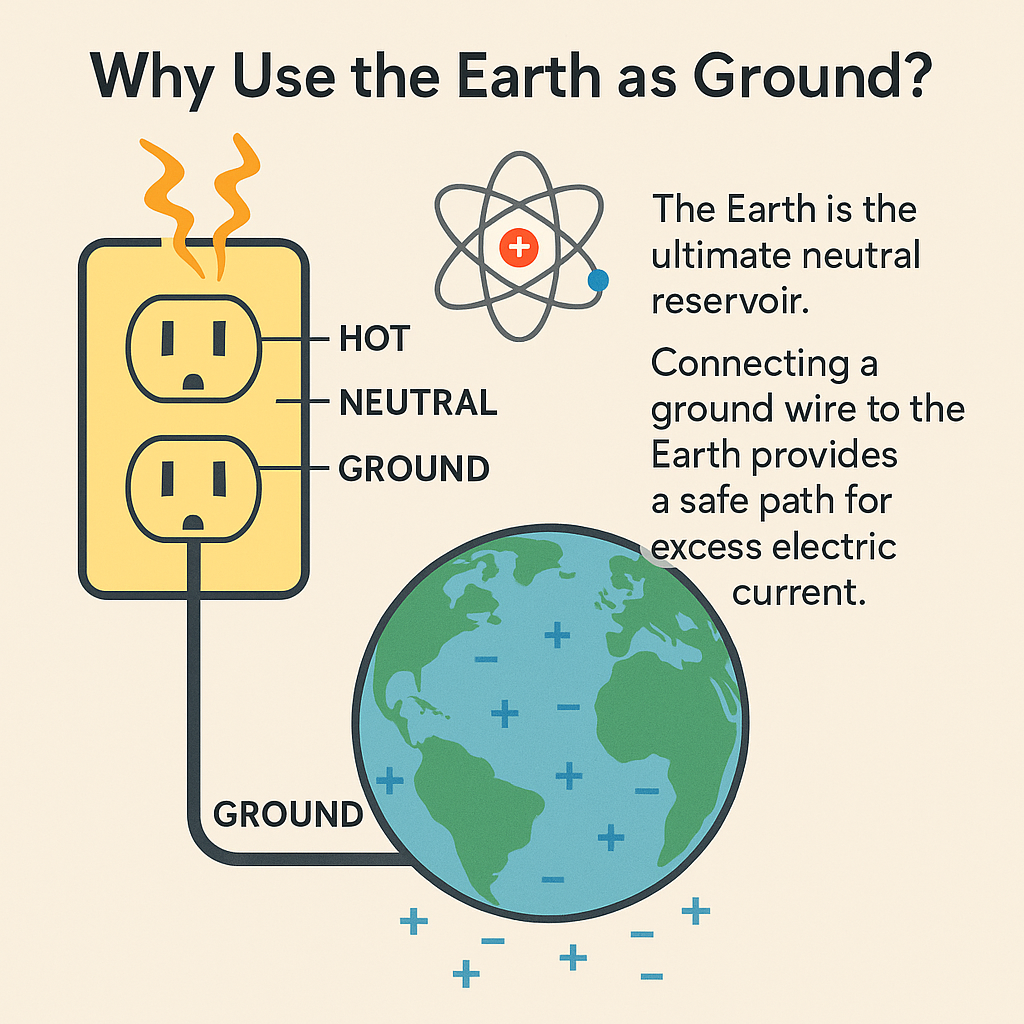
How does Earthing (Grounding) work?
In an electrical system, the ground prong gives current a low-resistance escape path into the Earth. That’s why a refrigerator or microwave doesn’t shock you if a wire comes loose inside. The Earth is essentially an infinite reservoir of charge that keeps the system safe and stable.
Biological grounding—or earthing—uses the same principle, but instead of protecting appliances, it helps stabilize your body.
Here’s the important part: electrons always flow from lower electric potential (more negative) to higher electric potential (more positive). If that sounds abstract, just remember this:
- Lower potential = more negative charge (more electrons).
- Higher potential = more positive charge (fewer electrons).
- Electrons, being negative, are always drawn toward the positive.
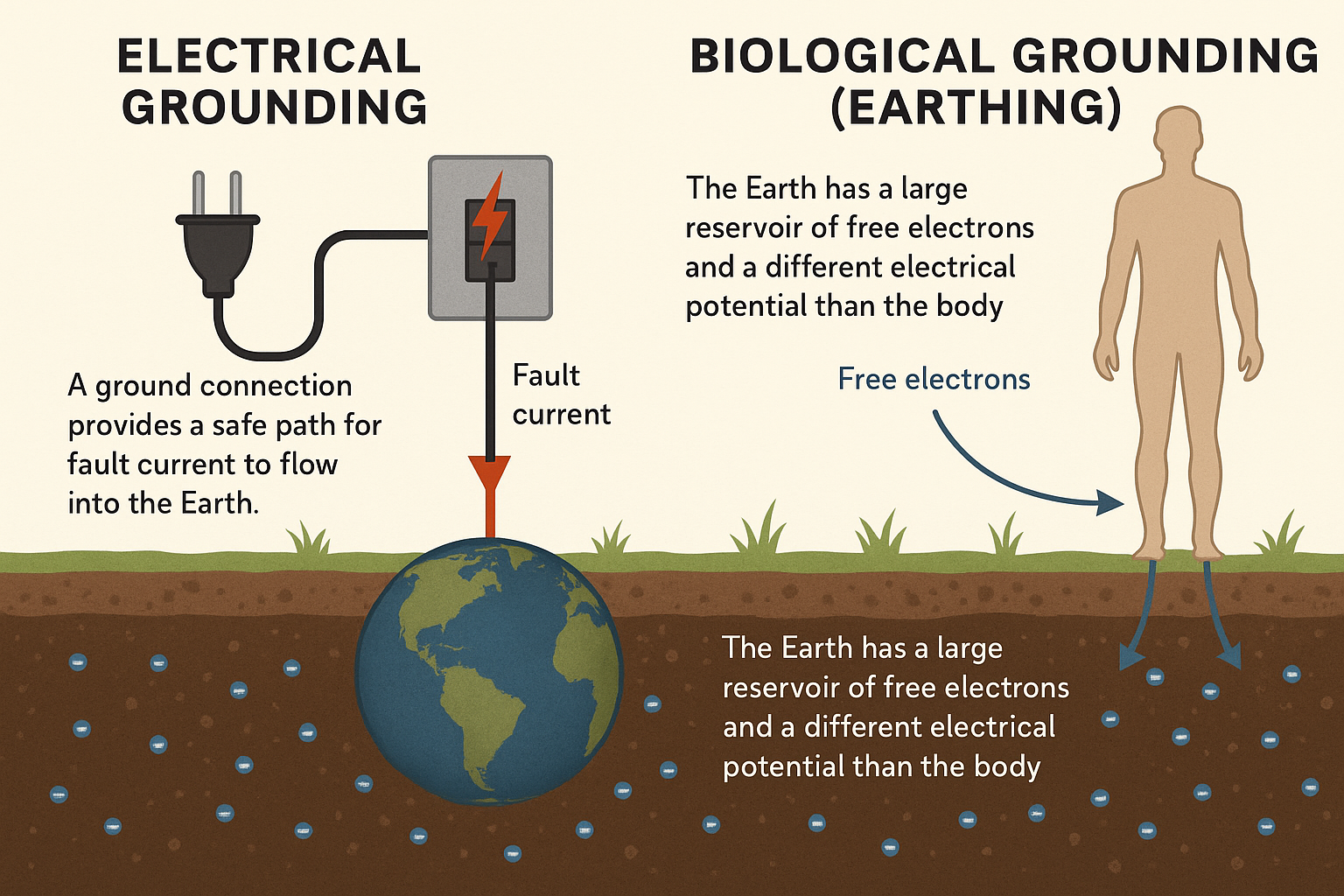
Electric potential, or voltage, is like the “push” behind electricity. It’s the electrical pressure difference that makes electrons move. Like water in a pipe.
- Voltage is water pressure.
- Current is the amount of water flowing.
- You can have high pressure but no flow (hose turned on but nozzle closed), or low pressure with steady flow (a wide stream). Both matter, but it’s the combination that determines how much useful work gets done.
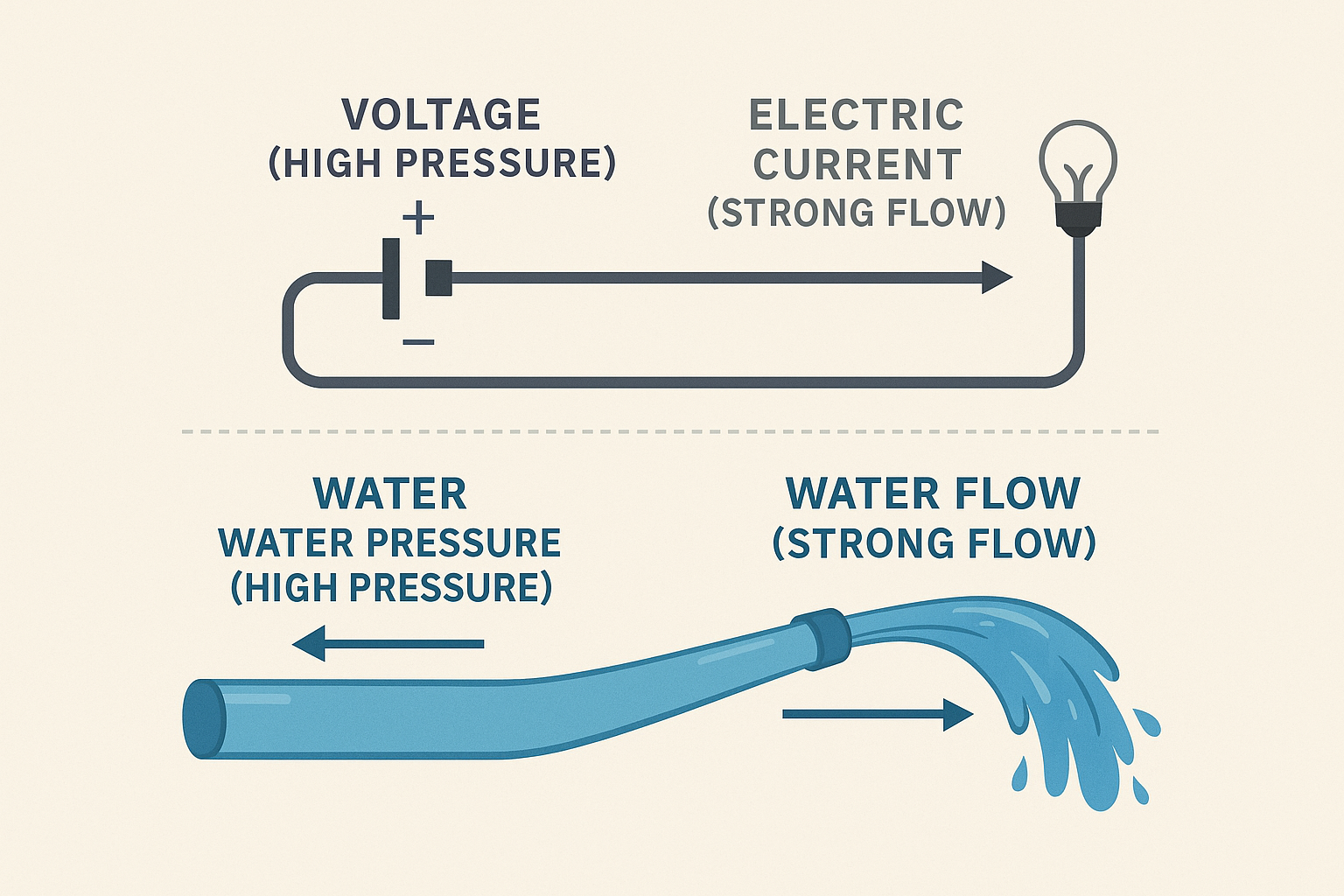
- The Earth: The Earth is defined as having 0 volts although the Earth’s surface is actually an immense reservoir of free electrons—effectively more negative than most things around it.
- The Human Body: Living in shoes, on insulated mattresses, and indoors all day means your body tends to accumulate a slight positive charge. In plain language, you become electron-deficient.
-
When You Connect: As soon as your bare skin touches the ground, electrons naturally flow from the Earth (more negative, lower potential) into your body (more positive, higher potential). They keep flowing until your body’s charge equalizes with the Earth’s.
Think of it like water levels: if the Earth is a giant lake and your body is a smaller tank sitting a little low, connecting them with a pipe allows water (electrons) to flow from the lake into the tank until the levels balance.
That’s all earthing is — a simple equalization process. But those extra electrons aren’t wasted. Research suggests they may act like antioxidants, neutralizing free radicals, stabilizing your cells’ electrical activity, and reducing inflammation.
Now that we understand how earthing works, the next question is: what are the actual benefits of grounding?
What are the health benefits of grounding?
So why might a person need to bring free electrons from the earth? In this section, I’ll cover both the benefits and the proposed mechanism of action of each benefit that’s been reported and confirmed by research.
Grounding has potent antioxidant action
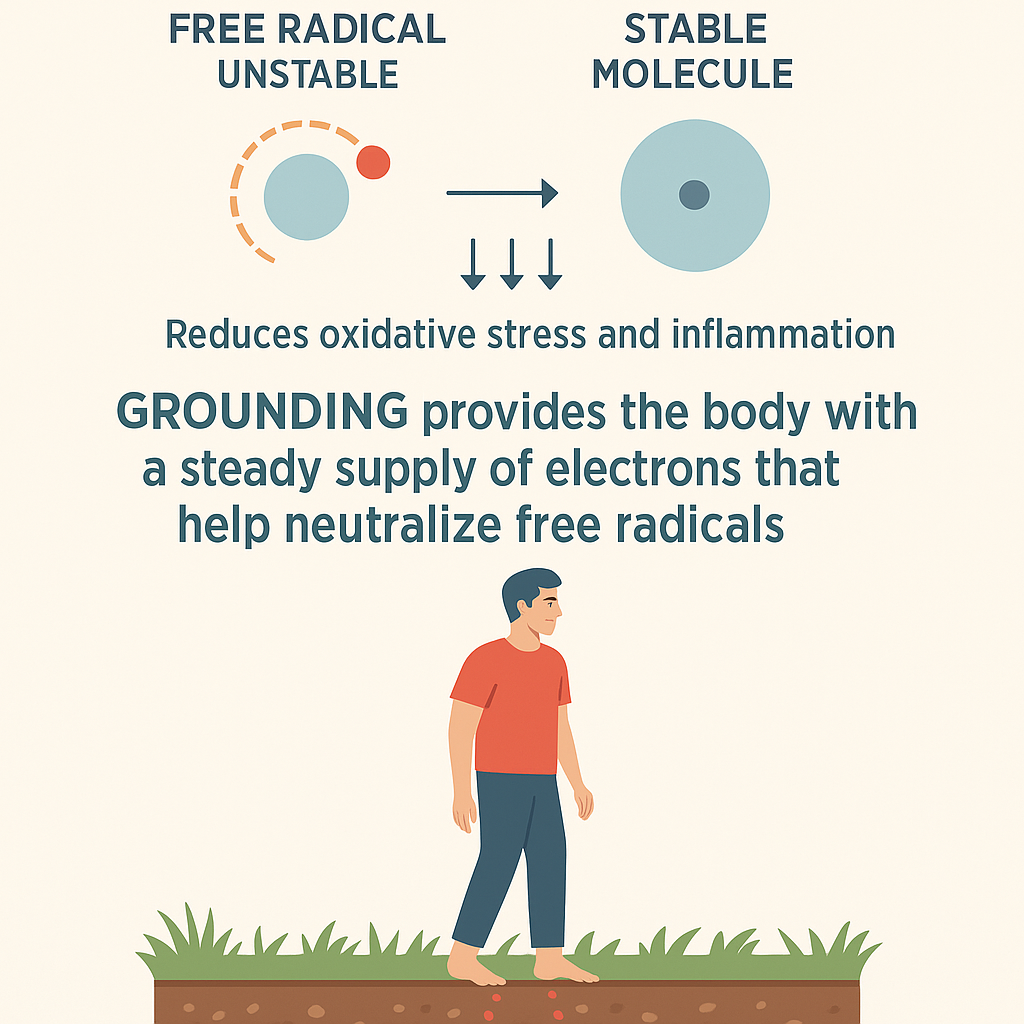
Most of the molecules in your body have stable electron pairs. Water, protein, carbohydrates, fat, DNA—pretty much anything you need to keep you alive has no desire most of the time to give or take extra electrons (this is simplified to avoid going deep into chemistry). Sometimes the electrons break free, and the molecule is kept in check by the body’s own antioxidant system.
Note: “Oxidation” is the technical term for when a molecule loses an electron. When a molecule gains an electron, it’s called “reduction.” From high school chemistry, you might remember “Leo the lion say ‘Ger’” to help you remember that Losing an Electron is Oxidation. Gaining an Electron is Reduction.” This is why it’s important to get antioxidants in your diet!
You have to understand something else about electrons: they hate being alone. Free radicals are unstable molecules that are missing an electron in their outer shell. Because electrons prefer to exist in pairs, this missing electron makes the molecule highly reactive — it will try to steal an electron from the nearest stable molecule it can find.
That electron theft sets off a chain reaction: the once-stable molecule that just lost an electron now becomes a free radical itself, and it goes looking for another electron to “steal.” This process, known as oxidative stress, can spiral out of control, causing cellular damage. In response, the body triggers an inflammatory reaction to try to repair the damage; however, when oxidative stress is chronic, this inflammation also becomes chronic.
Over time, the combination of oxidative damage and persistent inflammation contributes to aging and has been linked to cancer, heart disease, and neurodegenerative disorders like Alzheimer’s, dementia, and Parkinson’s disease.
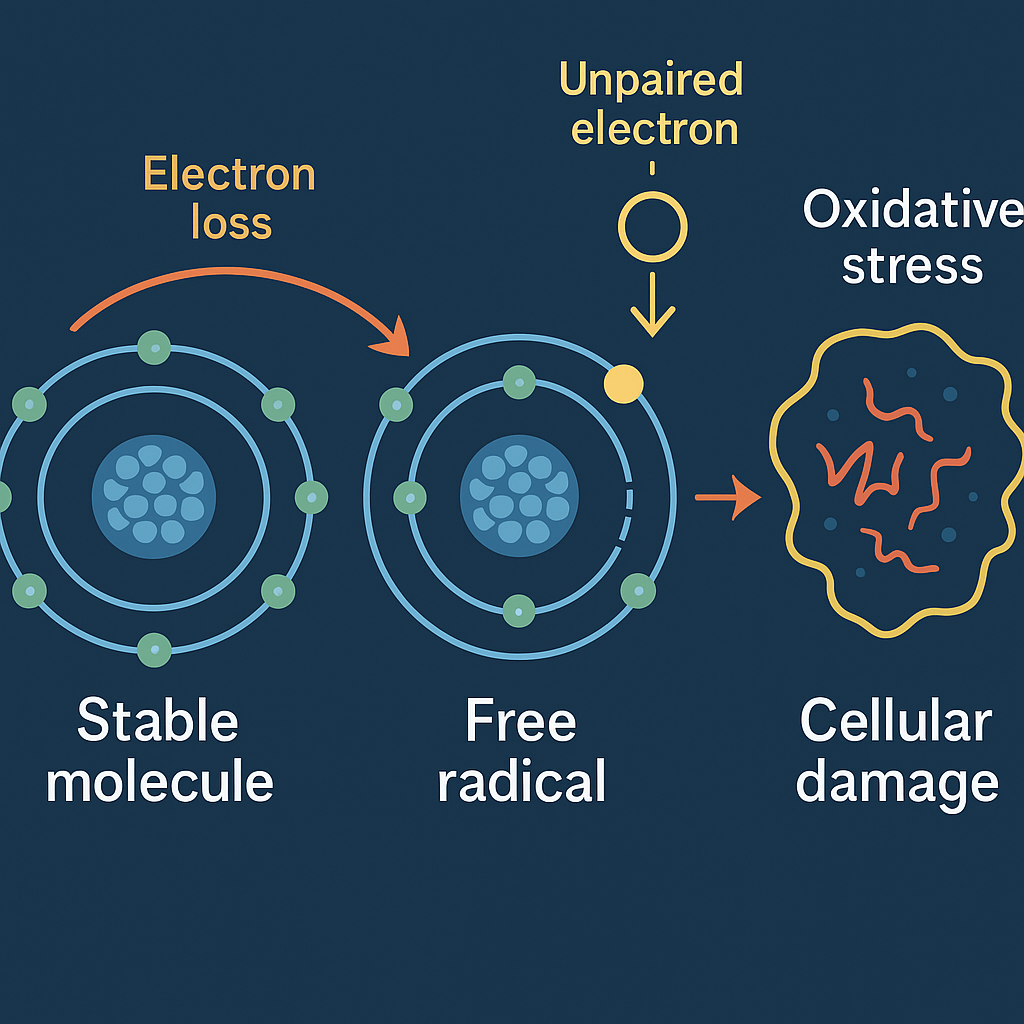
But if we can bring electrons into our body from the practice of grounding, then we can combat this free radical damage. Research has shown that this is exactly what happens.
- A paper titled “Can Electrons Act As Antioxidants? A Review And Commentary” says, “It is well established, though not widely known, that the surface of the earth possesses a limitless and continuously renewed supply of free or mobile electrons as a consequence of a global atmospheric electron circuit…It is also suggested that free electrons from the earth neutralize the positively charged free radicals that are the hallmark of chronic inflammation.” (Oschman, 2007)
- In a 2015 review published in the Journal of Inflammation Research, Oschman, Chevalier, and Brown report that grounding influences key inflammation markers and wound-healing processes (Oschman et al., 2015).
Grounding provides the body with a steady supply of electrons that help neutralize free radicals. These electrons reduce the oxidative stress that drives chronic inflammation.
Grounding makes your mitochondria perform better

Your mitochondria are like tiny batteries inside your cells. They make adenosine triphosphate (ATP), the molecule that powers almost everything your body does, by using food and oxygen to pump protons across a membrane and create a voltage difference called the mitochondrial membrane potential. Think of this like charging a phone battery: the right amount of charge keeps it running smoothly.
But just like a phone battery can be overcharged, mitochondria can sometimes hold on to too much potential. One of the biggest culprits is our modern sedentary lifestyle and diet. When you sit too much and eat excess calories (especially sugar and processed fats), mitochondria don’t burn fuel efficiently.
This creates an “energy traffic jam” where electrons pile up, the membrane potential gets too high, and instead of smoothly producing energy, mitochondria start leaking electrons. Those stray electrons react with oxygen and form reactive oxygen species (ROS) that can behave like free radicals.
Think of free radicals as molecules with a ‘lonely electron’ that makes them desperate to react. Reactive oxygen species (ROS) are a bigger family of oxygen-based troublemakers. Some are free radicals, others aren’t, but they all create oxidative stress and damage if not kept in check.
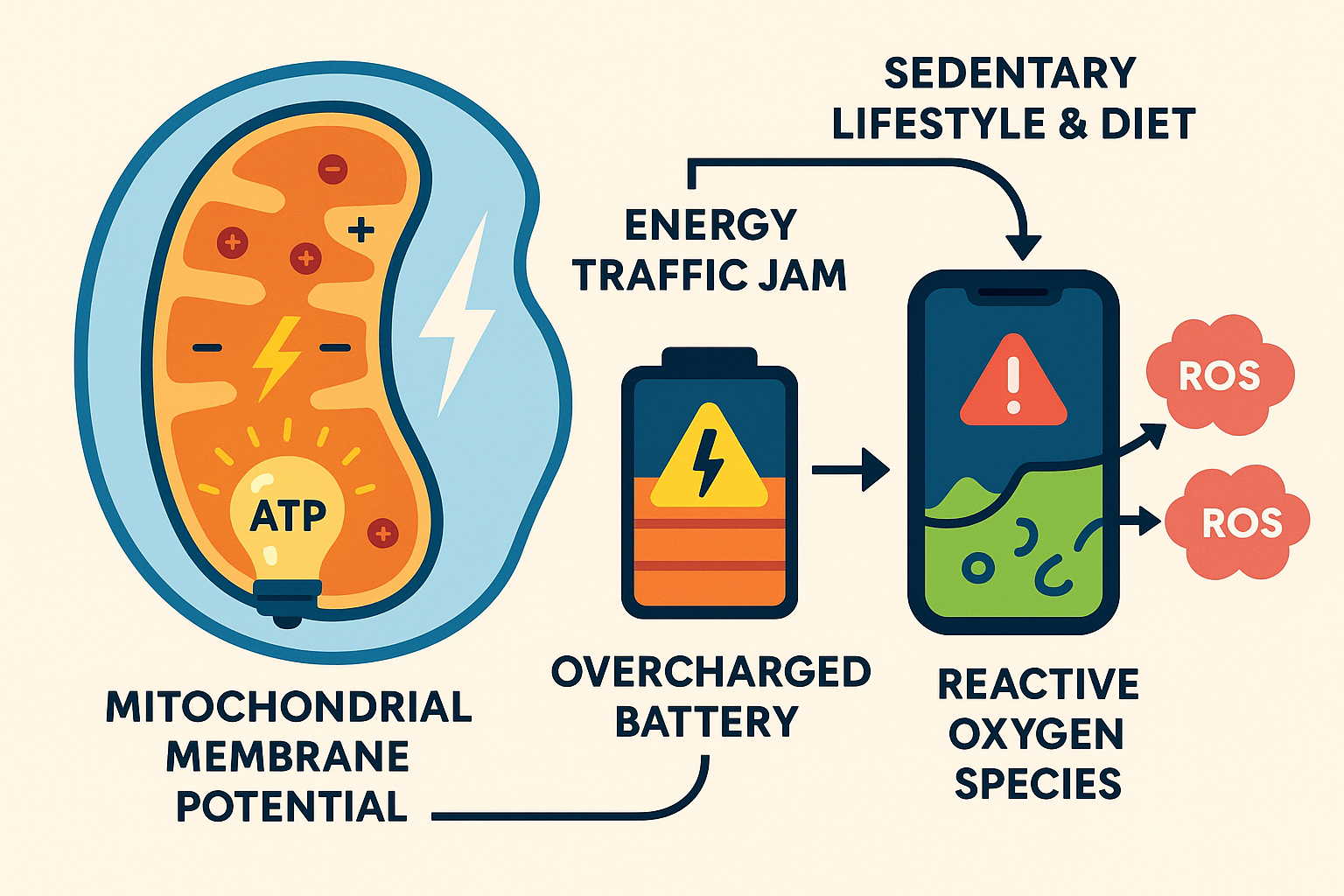
In small amounts, ROS are useful (your immune system uses them to kill pathogens), but too much creates oxidative stress that damages proteins, DNA, and cell membranes. Over time, this oxidative stress fuels inflammation, accelerates aging, and contributes to chronic conditions like cancers and cardiovascular and neurodegenerative diseases.
Research has shown that Grounding seems to prevent this overcharging problem.
By allowing electrons from the Earth to flow into your body, grounding acts like a pressure-release valve for your mitochondria. Instead of reactive oxygen species (ROS) clogging up the electron transport chain and driving the mitochondrial membrane potential too high, the incoming electrons help neutralize them, keeping energy production smooth, balanced, and efficient.
In fact, a 2025 study published in FEBS Open Bio found that mitochondria under grounded conditions produced 5–11% more ATP, generated 22–33% fewer ROS, and had a 5–6% lower mitochondrial membrane potential compared to sham and untreated samples — suggesting grounding helps your cells’ batteries run in their optimal “sweet spot” (Giulivi, 2025).
There are more research findings below, but if you want to get a Grounding Mat or Grounding Sheet, check out Grounding Well. They’re the same company I got mine from and they’re a solid company that makes a great product.
Grounding Stabilizes Your Nervous System
A surge protector is a safety device that shields your electronics from sudden voltage spikes. Under normal conditions, electricity flows through it. But when there’s a surge—caused by lightning, grid fluctuations, or large appliances switching on—the surge protector instantly diverts the extra voltage into the ground. This prevents the electrical spikes from damaging your devices and protects the system by smoothing out dangerous fluctuations.
Your cells work in much the same fashion.
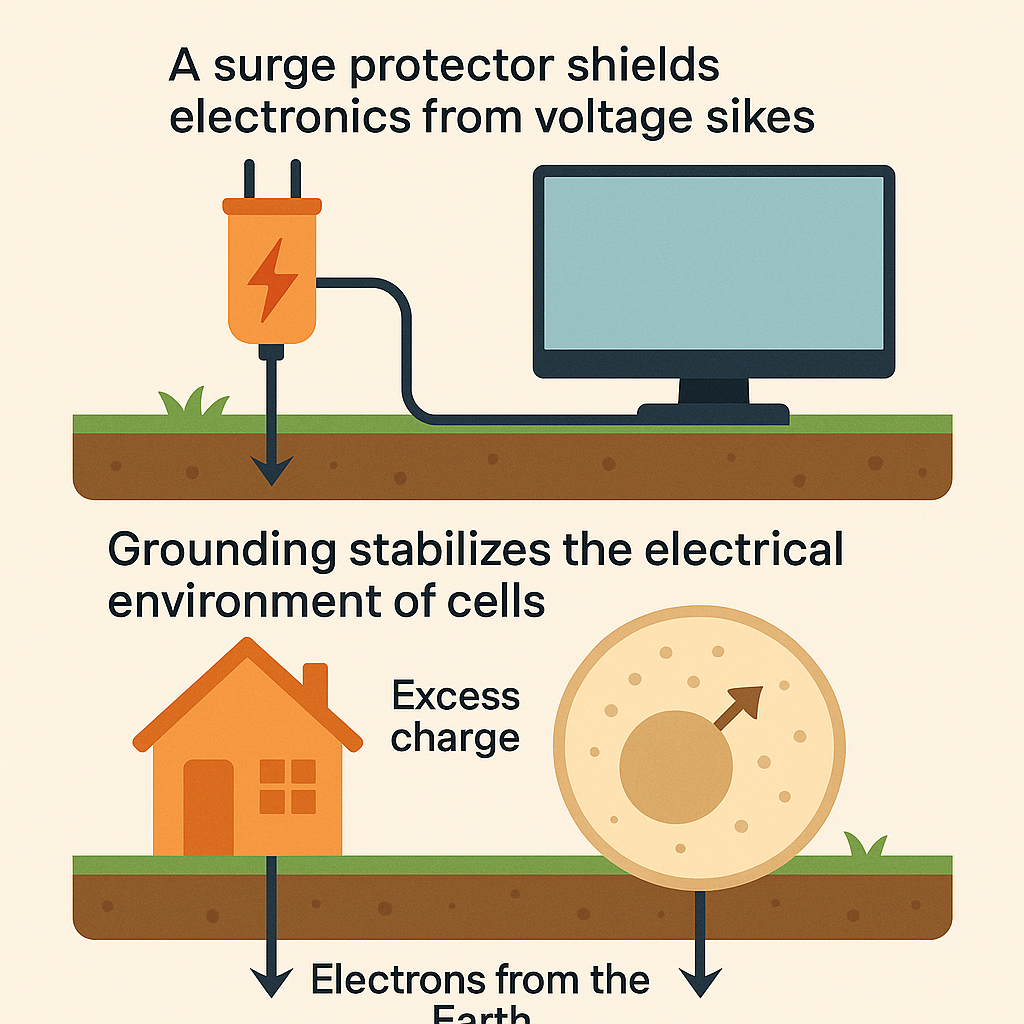
Imagine each cell as a tiny house with its own wiring system. For the house to run smoothly, its voltage has to stay steady—otherwise, the lights flicker and the appliances fail. Stress, free radicals, and environmental electrical “noise” act like power surges that throw off this balance. Grounding gives those little houses a built-in surge protector: electrons from the Earth flow in, absorb excess charge, and stabilize the voltage so the “wiring” inside each cell can function properly.
Just like every house has its own electrical supply, every cell maintains its own electric potential—the voltage difference between the inside and outside of its membrane. This potential is created by carefully moving charged particles, such as sodium, potassium, and calcium, across the cell wall, and it’s essential for life. It powers nerve signals, muscle contractions, and the transport of nutrients.
However, when oxidative stress or an excess of positive charge disrupts this balance, cells struggle to perform their functions. Grounding restores stability by letting electrons flow from the Earth into your body, neutralizing those excess charges and keeping the “lights on” inside your body’s cellular houses.
This stabilization is especially important for the nervous system, which runs entirely on electrical signals. Every thought, reflex, and movement depends on voltage changes racing along nerve cells. When those voltages are stable, the system runs smoothly. But when electrical balance is disrupted, signals become noisy, and the body leans toward “fight-or-flight” mode.
Grounding helps quiet that noise by supplying electrons that steady the voltage across nerve cell membranes. Research shows that this is reflected in heart rate variability (HRV), a marker of how well your body transitions between stress and recovery. Grounding tends to shift HRV toward greater parasympathetic activity, the “rest-and-recover” state, helping the body calm stress responses, build resilience, and recover faster.
Here are the studies that show how grounding can positively affect heart rate variability.
Grounding & HRV Research Findings
- In a pilot study of 27 participants, researchers found that grounding led to significant improvements in HRV that exceeded the effects of simple relaxation (p < .01) [Chevalier et al., 2012].
- Another study reported that grounding during sleep improved vagal tone and increased parasympathetic activity, as reflected in HRV measures [Ghaly & Teplitz, 2004].
- A larger review noted consistent evidence that grounding reduces sympathetic overdrive and supports autonomic balance (Oschman et al., 2015).
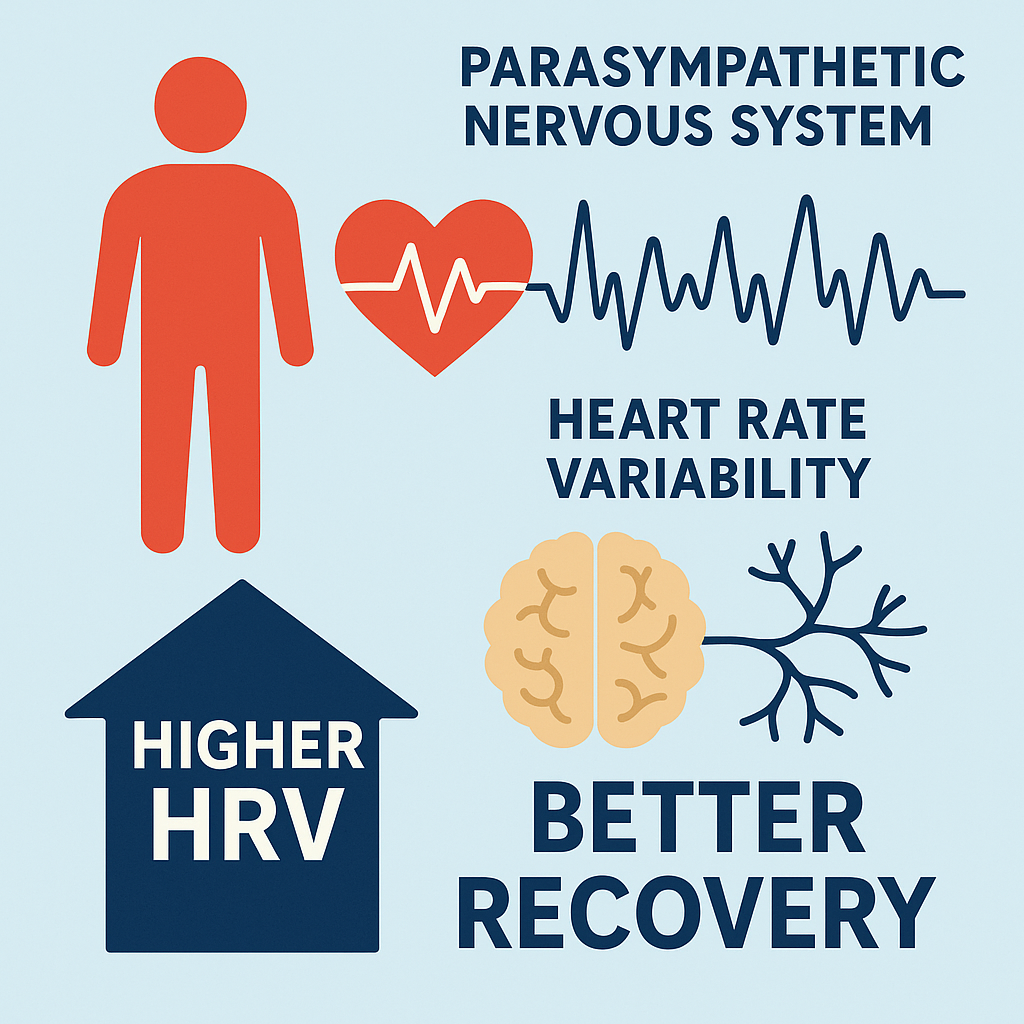
In short, grounding works like a natural reset button for your nervous system. By stabilizing the electrical activity of your cells, it helps quiet stress signals and restore balance between “fight-or-flight” and “rest-and-recover.” The result is a calmer, more resilient body that can better handle daily stressors and recover more effectively.
Grounding helps you to sleep better
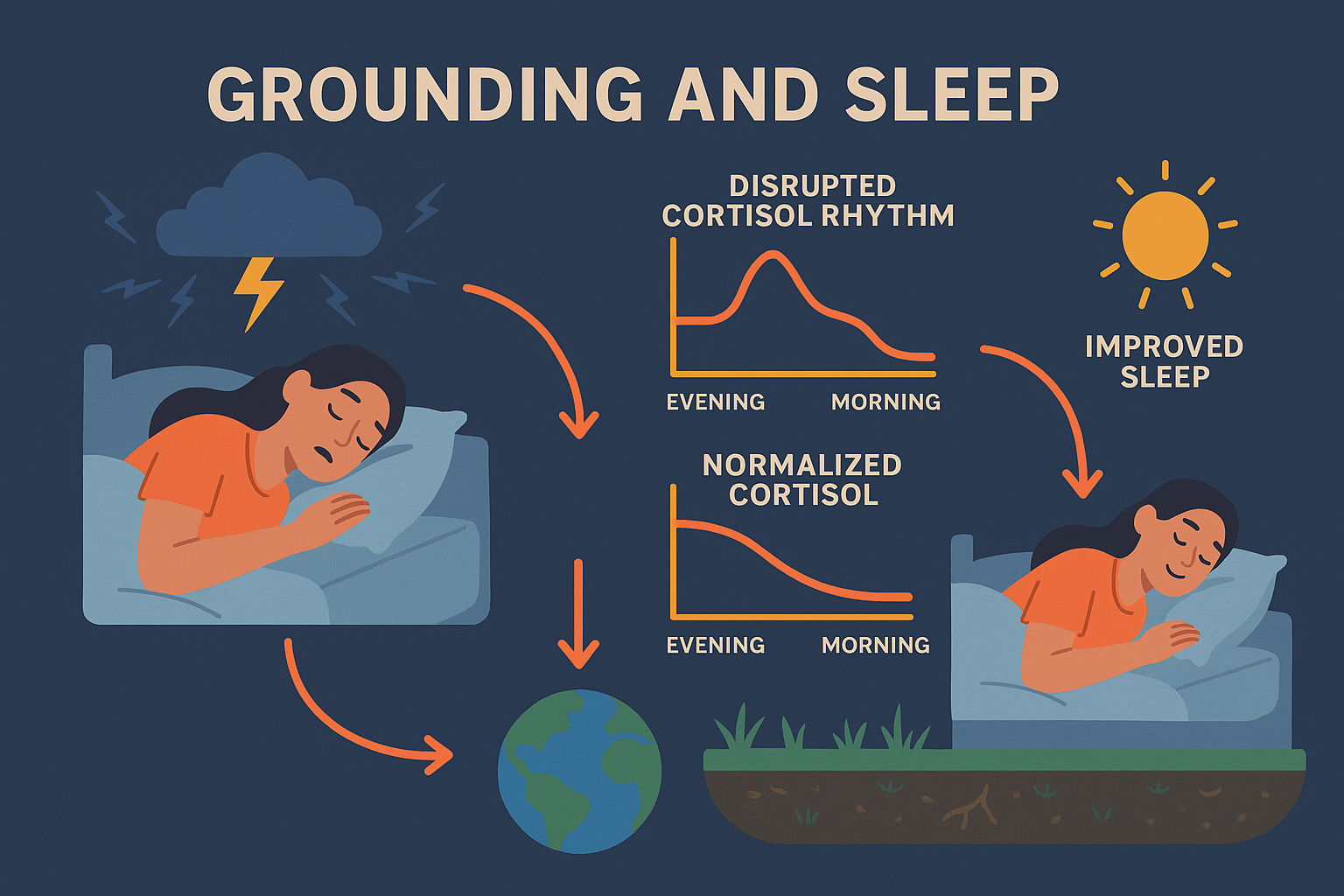
One of the clearest benefits of grounding, most replicated benefits of grounding across all research studies is the improvement of sleep.
Sleep is when your body repairs, resets, and restores itself but for many people, stress, inflammation, and modern lifestyle habits get in the way. Grounding seems to address these barriers directly, helping the body synch up better with its circadian rhythm. .
One way grounding may work is by normalizing cortisol rhythms. Cortisol is your main stress hormone, and it should be lowest at night so you can fall asleep, then peak in the morning to wake you up. But chronic stress and artificial light often disrupt this cycle, keeping cortisol elevated at night and making more difficult to fall and stay asleep.
In a pilot study where participants slept on grounded mattress pads and researchers found that nighttime cortisol levels dropped and 24-hour cortisol rhythms became more regular. Participants also reported falling asleep faster, waking less often, and feeling more refreshed in the morning (Ghaly & Teplitz, 2004).
More recent research strengthens the case. A 2025 study found that participants using grounding mats saw reductions in insomnia severity and daytime sleepiness, pointing to measurable improvements in sleep quality and next-day functioning (Park et al., 2025).
When you put all of this together, a picture emerges: grounding doesn’t act like a sedative to “knock you out.” Instead, it helps remove the barriers that disrupt natural sleep — stabilizing stress hormones, calming the nervous system, and reducing pain and inflammation. The result is that you fall asleep more easily, sleep more deeply, and wake up feeling genuinely restored.
Grounding improves bloodflow and circulation
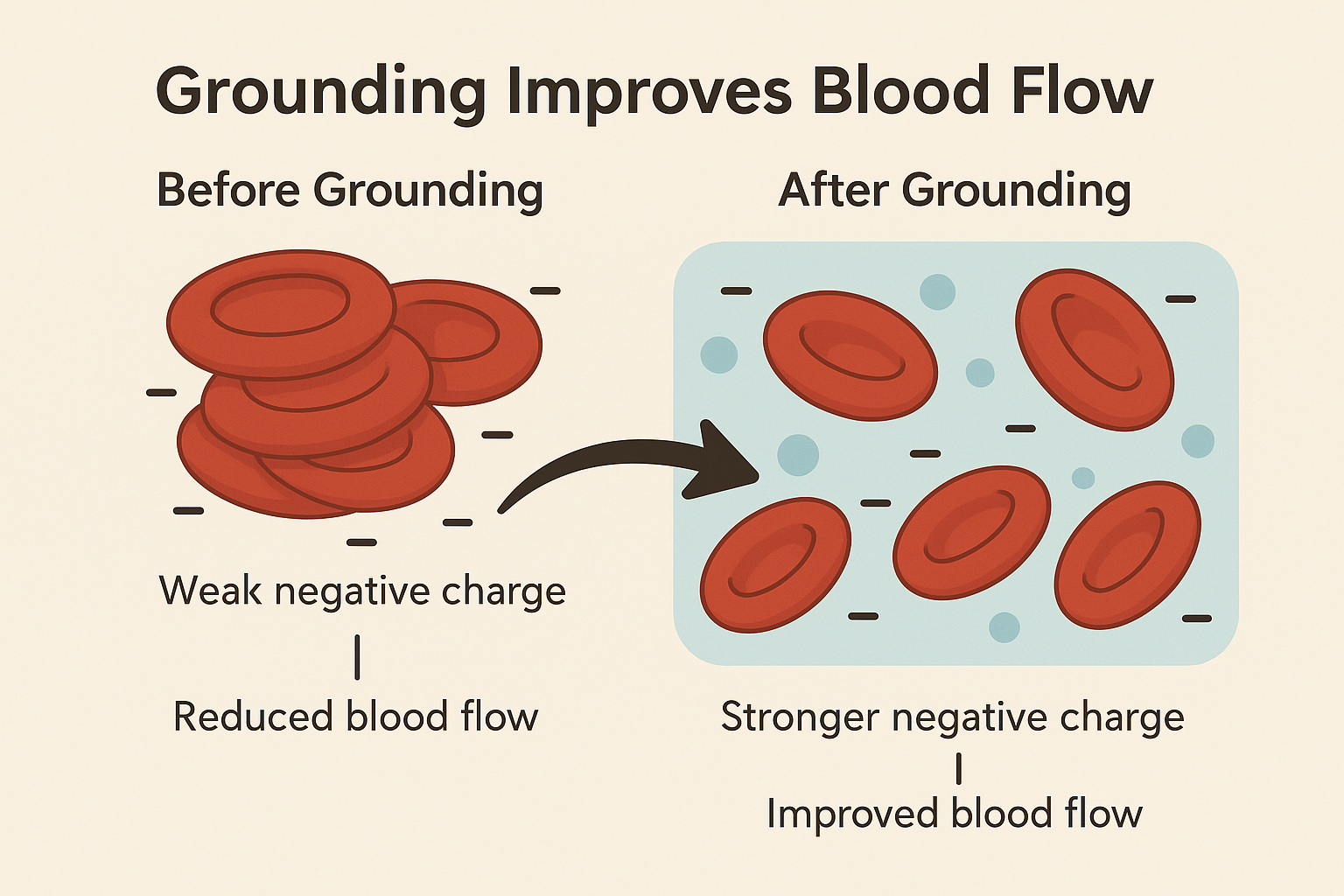
Another way grounding may benefit the body is by improving blood flow. Your red blood cells (RBCs) carry oxygen to every tissue, but how smoothly they travel depends on their surface charge, known as zeta potential.
When RBCs have a strong negative charge, they naturally repel each other—like two magnets with the same pole—so they flow freely through blood vessels. But when that charge is weakened, the cells start sticking together, forming clumps that slow circulation and make it harder for oxygen to reach tissues. This sticky blood also increases the risk of inflammation, pain, and cardiovascular strain over time.
Several factors can weaken this charge. Oxidative stress, chronic inflammation, exposure to environmental pollutants, and even poor diet or dehydration can all strip away the natural negative charge on RBCs. As the surface charge weakens, red blood cells lose their repulsion and begin stacking together in clumps (a phenomenon called rouleaux formation), making circulation sluggish and less efficient.
Grounding appears to counteract this effect by supplying electrons that slightly increase the negative surface charge on red blood cells, restoring their natural repulsion and improving flow. In a controlled study, Chevalier and colleagues found that just two hours of grounding significantly reduced RBC aggregation, suggesting that grounding helps blood move more freely and delivers oxygen more effectively throughout the body [Chevalier et al., 2013, Journal of Alternative and Complementary Medicine].
 By thinning the blood in this natural way—not by removing cells, but by improving their spacing—grounding may reduce cardiovascular strain, support tissue repair, and enhance overall circulation.
By thinning the blood in this natural way—not by removing cells, but by improving their spacing—grounding may reduce cardiovascular strain, support tissue repair, and enhance overall circulation.
So now that we know the benefits of grounding and see that the research is there to back them up, that naturally leads us to problem:
If walking around on bare Earth is so powerfully healthy, how are are supposed to do this in modern society? We walk on the pavement, live in buildings, wear shoes and and socks, and are in everyway disconnected from the Earth?
It’s a reasonable question and the modern state of the world and our disconnect from the earth is likely partially to blame for the chronic illness that plaugues modern society. Well fortunately, modern technology has given us a way get the same effects of grounding in the comfort of our own homes.
Pick up a Grounding Mat or Grounding Sheet at Grounding Well. I have them both so I get the benefits of grounding while I’m working and while I’m sleeping.
How Grounding Sheets and Mats Work
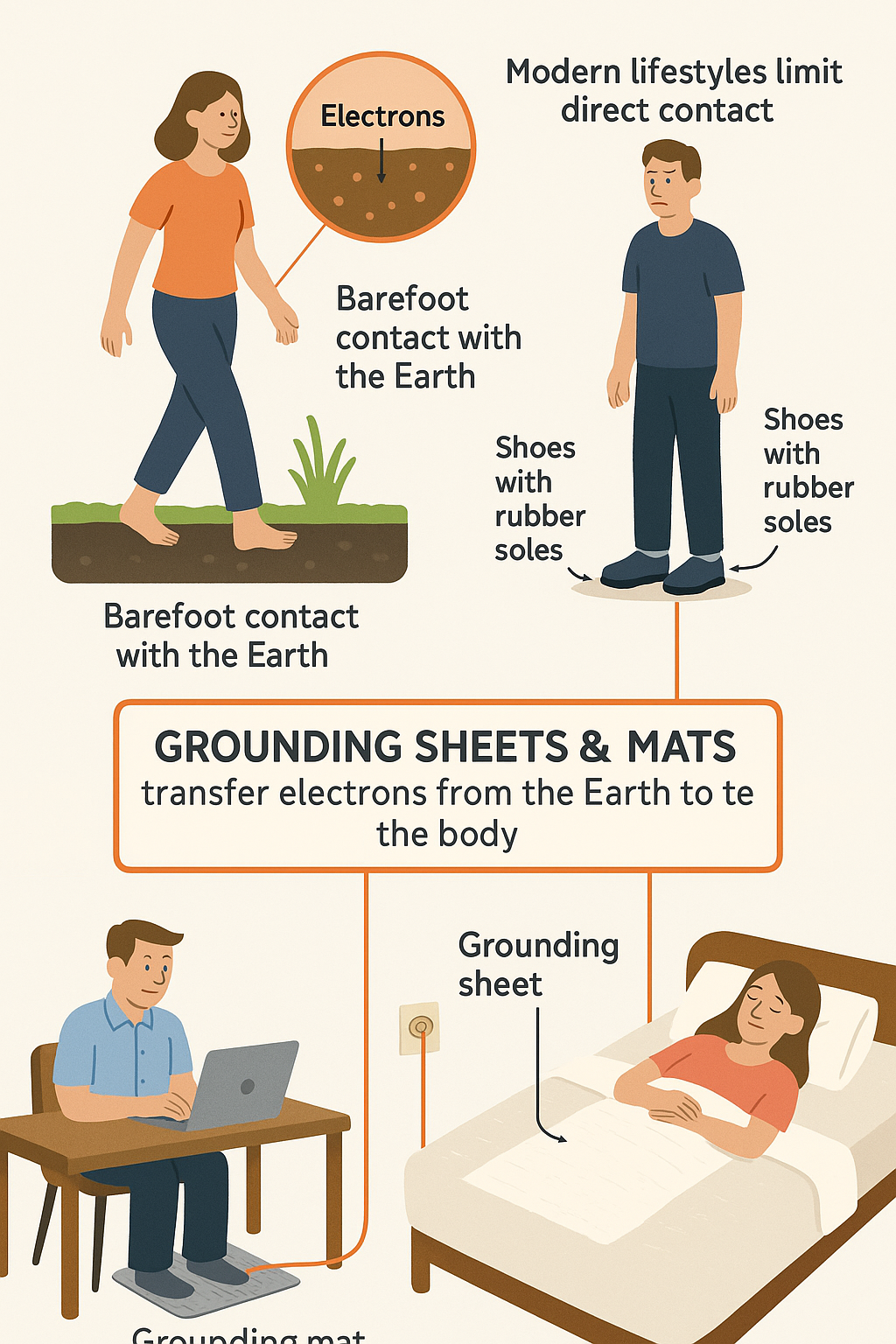
Everything we’ve covered so far—neutralizing free radicals, stabilizing nervous system voltage, and improving blood flow—relies on one simple thing: the transfer of electrons from the Earth into your body.
Barefoot contact with soil, grass, or sand is the most natural way to receive those electrons. But modern life makes that hard. We spend most of our time indoors, wearing shoes with rubber soles, and sleeping on insulated beds that block contact with the Earth.
That’s where grounding sheets and mats come in. These devices are made with conductive materials (usually silver threads or carbon fibers) that are woven into fabric or embedded into a mat. When they’re connected to the ground port of a wall outlet—or to a grounded rod placed directly in the Earth—they create a direct electrical pathway between your body and the Earth’s surface.
In other words, when you lie on a grounding sheet or rest your feet on a grounding mat, electrons can flow from the Earth, through the conductive material, and into your body exactly as if you were standing barefoot outside. This allows you to bring the benefits of grounding—reduced oxidative stress, stabilized cellular voltage, calmer nervous system activity, and improved circulation—into your daily life, even while you work at a desk or sleep at night.
Think of grounding sheets and mats as an extension cord to the Earth. They make sure your body stays “plugged in,” even in the environments that usually cut you off from the flow of electrons.
Check out Grounding Well. That’s where I got both my Grounding Mat and Grounding Sheet from. If you purchase here, I receive a small commission that goes a long way in supporting my conte.t
Grounding Mats and Grounding Sheets That I Use
I use products by Grounding Well. They carry a high quality grounding matts, ground sheets, and grounding accessories. All of their products work on the same principles described in this article and bring some incredible benefits.
If this article helped to push you over the edge about buying a a Grounding Mat or Grounding Sheet, I’d be grateful if you purchased through any of the links in this article that take you to the Grounding Well website.
Grounding has made a difference in my life and I know it will do the same for you.

